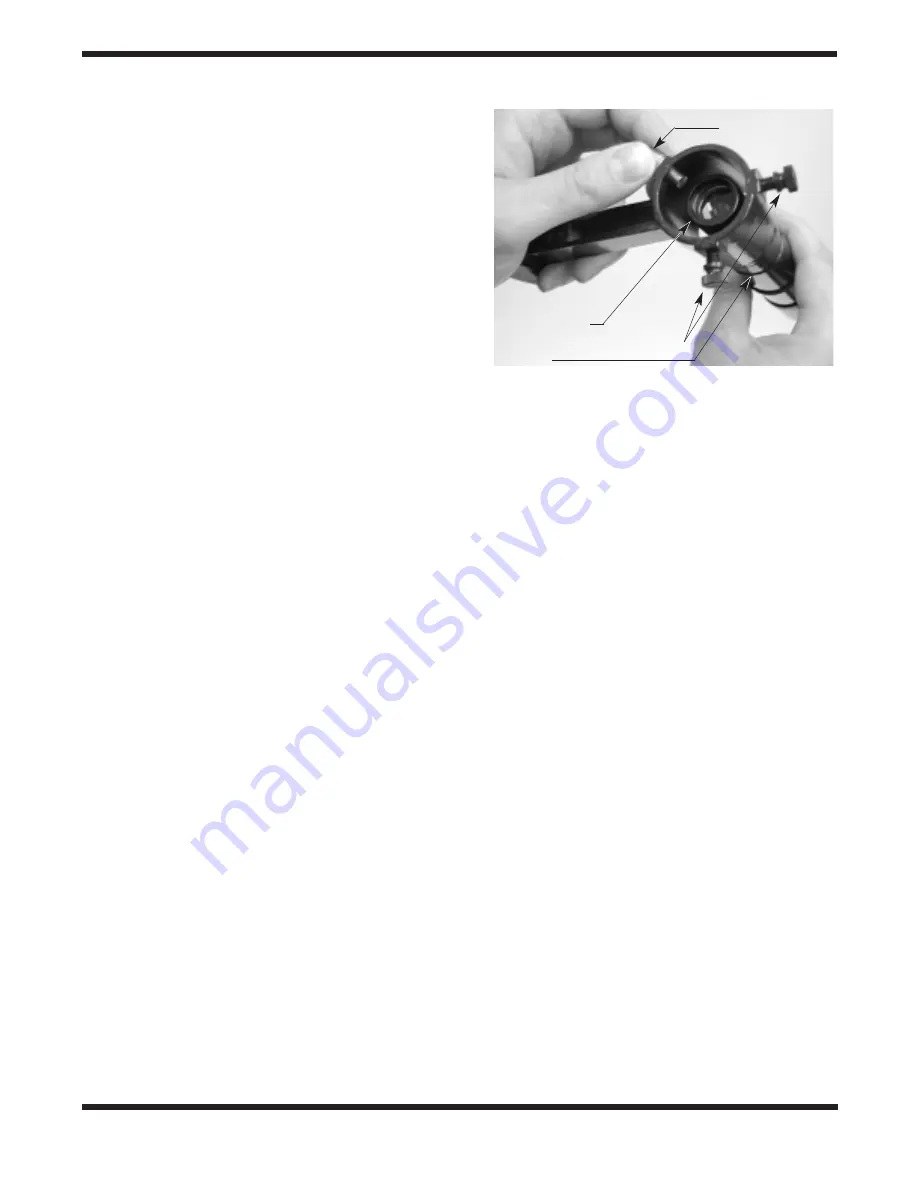
5
sure to loosen the R.A. and Dec. lock knobs before doing
this. Retighten the R.A. and Dec. lock knobs once the
equatorial mount is properly oriented.
7. Slide the counterweight onto the counterweight shaft.
Make sure the counterweight lock knob is adequately
loosened to allow the counterweight shaft to pass through
the hole in the counterweight.
8. With the counterweight lock knob still loose, grip the coun-
terweight with one hand and thread the shaft into the
equatorial mount (at the base of the declination axis) with
the other hand. When it is threaded as far in as it will go,
position the counterweight about halfway up the shaft and
tighten the counterweight lock knob. The retaining screw
and washer on the bottom of the shaft prevent the coun-
terweight from falling off (and onto your foot!) if the
counterweight lock knob becomes loose.
9. Attach the 1/4"-20 adapter to the top of the equatorial
mount using the bolts and washers that come with the
adapter. Push the bolts, with washers attached, up
through the holes in top of the mount and thread them into
the bottom of the adapter. Tighten the bolts securely with
the supplied wrench.
10. Connect the optical tube assembly to the 1/4"-20 adapter
on the mount by threading the adapter’s shaft into the hole
in the optical tube’s mounting block. Orient the optical tube
so that is parallel to the length of the adapter, as it is in
Figure 1. Tighten this connection firmly by rotating the
knurled thumb wheel on the adapter counter-clockwise.
11. Attach the two slow-motion cables to the R.A. and Dec.
worm gear shafts of the equatorial mount by positioning
the thumb screw on the end of the cable over the indented
slot on the worm gear shaft and then tightening the thumb
screw. We recommend that the shorter cable be used on
the R.A. worm gear shaft and the longer cable on the Dec.
worm gear shaft. The Dec. worm gear shaft and cable
should extend toward the rear of the optical tube, as is
shown in Figure 1. If it does not, you will need to rotate the
optical tube 180° on the 1/4"-20 adapter. Do this by first
loosening the adapter’s knurled thumb wheel.
12. To place the finder scope in the finder scope bracket, first
unthread the two black nylon screws until the screw ends
are flush with the inside diameter of the bracket. Place the
O-ring that comes on the base of the bracket over the
body of the finder scope until it seats into the groove on
the middle of the finder scope. Slide the eyepiece end
(narrow end) of the finder scope into the end of the brack-
et’s cylinder that does not have the alignment screws
while pulling the chrome, spring-loaded tensioner on the
bracket with your fingers (see Figure 3). Push the finder
scope through the bracket until the O-ring seats just inside
the front opening of the bracket’s cylinder. Now, release
the tensioner and tighten the two black nylon screws a
couple of turns each to secure the finder scope in place.
The tips of the tensioner and nylon screws should seat
into the wide groove on the rear of the finder scope’s body.
Figure 3.
To install the finder scope in the finder
scope bracket, pull the spring-loaded tensioner while
inserting the eyepiece end of the finder scope into
the bracket.
13. Insert the base of the finder scope bracket into the dove-
tail holder on the optical tube. Lock the bracket into
position by tightening the knurled thumb screw on the
dovetail holder.
14. Remove the cap from the eyepiece adapter on the rear of
the optical tube and insert the chrome barrel of the mirror
star diagonal. Secure the diagonal with the thumb screws
on the eyepiece adapter.
15. Insert the chrome barrel of the eyepiece into the star diag-
onal. Secure the eyepiece with the thumb screws on the
star diagonal.
The telescope system is now fully assembled. Keep the dust
cover over the front end of the telescope when it is not in use.
It is also a good idea to cover the eyepiece; use the cover cap
that came with it.
4. Getting Started
Balancing the Telescope
To insure smooth movement of the telescope on both axes of
motion (R.A. and Dec.) of the equatorial mount, it is impera-
tive that the optical tube be properly balanced.
1. Keeping one hand on the telescope optical tube, loosen
the R.A. lock knob. Make sure the Dec. lock knob is locked.
The telescope should now be able to rotate freely about
the R.A. axis. Rotate it until the counterweight shaft is par-
allel to the ground (i.e., horizontal).
2. Loosen the counterweight lock knob and slide the counter-
weight along the shaft until it exactly counterbalances the
telescope (Figure 4a). That’s the point at which the shaft
remains horizontal even when you let go of the telescope
with both hands (Figure 4b).
3. Retighten the counterweight lock knob.
Spring-loaded
tensioner
Eyepiece end of
finder scope
Alignment thumb screws
O-ring
Summary of Contents for StarMax 102mm EQ
Page 15: ...15...





















